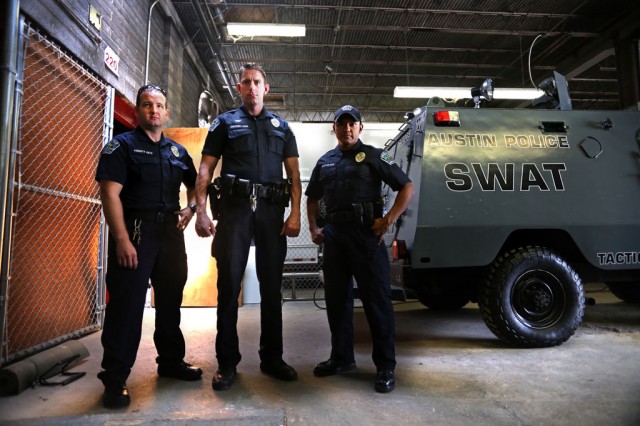Travis County Agencies Take Advantage of Weapons Program

Austin Police officers Khristof Oborski, Alfredo Gonzales and Jon Abbott with an armored vehicle obtained through the federal surplus weapons program. Photo by Juan Pablo González/Reporting Texas
By Alisa Semiens
For Reporting Texas
Law enforcement authorities in Travis County can call on a small arsenal of surplus military weapons should the need arise, including eight combat vehicles worth more than $3.6 million and 111 assault weapons worth $21,746.07, according to records compiled by the federal Defense Logistics Disposition Services.
The combat vehicles and weapons are available through a program Congress created in 1990 to help local, state and federal agencies fight crime, particularly drug- and terror-related activities. Michelle McCaskill, spokeswoman for the Law Enforcement Support Office at the U.S. Department of Defense, said more than 8,000 federal, state and local law agencies participate.
Because of security worries, McCaskill said, she could not identify which agencies in Travis County received the vehicles and weapons. The Austin Police Department acknowledges it has received two armored vehicles.
Use of military-grade weapons by local police came under scrutiny after police in Ferguson, Mo., deployed armored vehicles and other military weapons in response to civil unrest after the shooting death of Michael Brown on Aug. 9, 2014. Brown, an unarmed teenager, was shot by Ferguson police officer Darren Wilson in August. A U.S. Senate committee has conducted hearings on whether the surplus weaponry program should continue.
Defenders say the 1033 program, as it is known, gives police tools they need in situations involving dealing with active shooters and other violent situations.
Critics counter that the program was created with good intentions, but that as the police weapons become more militarized, so do police.
McCaskill said that 95 percent of the equipment provided through the program comprises noncombat items such as office equipment, tents, boots, computers and commercial vehicles. Defense Department records identify exactly which agencies receive the noncombat equipment. About 4 percent of the items are weapons, and less than 1 percent are combat vehicles, she said. Defense Department records show only the counties where those items end up.
Police departments in Austin and Elgin, as well as the Travis County Sheriff’s Department, have received equipment through the program, as have agencies in Bastrop, Hays and Williamson counties. Records show that weapons have gone to other, unspecified agencies in all four counties as well.
Commander Todd Gage of the Austin Police Department said it has received three M14 rifles through the program. Officers don’t carry them routinely, he said. Unless needed, they’re stored in a secure vault.
“Our officers have regular weapons,” Gage said. “Each officer is assigned a handgun, a .40-caliber handgun.”
According to records, Austin police also have received a helicopter, helmets, face shields, goggles, knee and elbow pads, backpacks, hydration packs and protective gear.
Elgin Police Chief Chris Bratton said 90 percent of the equipment his department has received through the program has been furniture. The department also has acquired a generator, trailers, 16 rifles and 12 handguns. Officers carry the rifles on routine patrols, he said.
“Having a patrol rifle is good tactical business. It is too late when you have an active shooter in a school,” Bratton said.
Randy Holland, chief of the Johnson City Police Department, said his officers “are not required to get permission from a supervisor. They can use the equipment in a negative situation.”
According to the Defense Logistics Disposition Services website, each agency that acquires equipment is responsible for training personnel in its proper use, maintenance and repair.
In Johnson City, officers “all have to qualify with the firearms that they take into the field. They have to shoot a certain percentage, at least 80 percent to 90 percent,” Holland said.
Elgin also requires officers to go through training.
“We train quite rigidly with firearms. Our officers have to qualify with the equipment at least once or twice a year. Every officer has a week of patrol rifle training before they can qualify to carry it, and then the weapon is assigned to them,” Bratton said.
While police officers in the Austin area think the program is necessary to save lives, critics say it is giving police officers an excuse to use deadly force. Police officers have become too forceful instead of relying on tactics such as communication or less lethal weapons, said Nelson Linder, president of the NAACP Austin Chapter.
“It came from a good idea. However, police stations have become more militarized, and police officers have become more aggressive in many ways in which they don’t have to be,” Linder said.